A series of books and volumes exclusively marketed through HorseFeathersRanch.com
-
Sale!Out of stock

 Primitive Archer Ball cap. One size fits most.
Primitive Archer Ball cap. One size fits most. -
Sale!
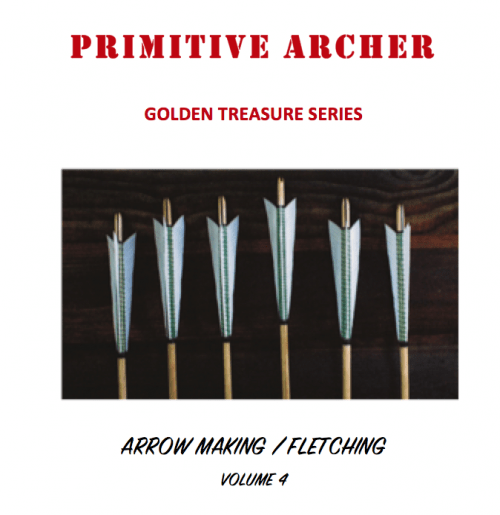
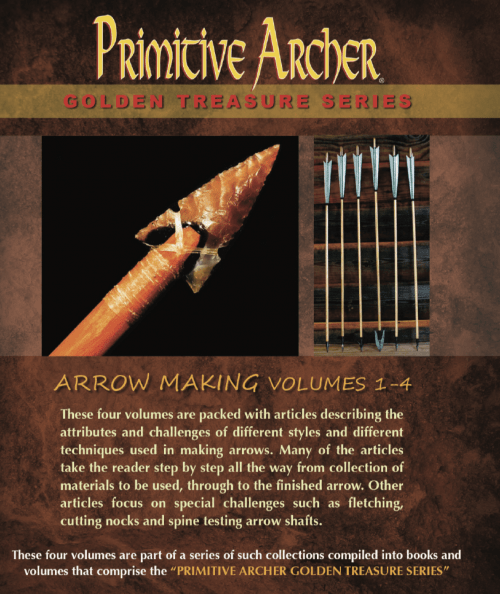 We are offering these 4 volumes that are packed with articles describing the attributes and challenges of different styles and different techniques used in making arrows. Many of the articles take the reader step by step all the way from collection of materials to be used through to the finished arrow. Other articles focus on special challenges such as fletching, cutting nocks and spine testing arrow shafts.
We are offering these 4 volumes that are packed with articles describing the attributes and challenges of different styles and different techniques used in making arrows. Many of the articles take the reader step by step all the way from collection of materials to be used through to the finished arrow. Other articles focus on special challenges such as fletching, cutting nocks and spine testing arrow shafts. -
Sale!
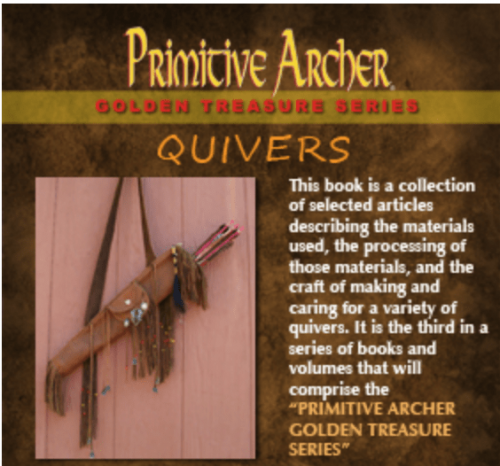 This book is one of our Golden Treasure Series that is a compilation of articles all related to the craft of making and caring for a variety of quivers.
This book is one of our Golden Treasure Series that is a compilation of articles all related to the craft of making and caring for a variety of quivers. -
Sale!
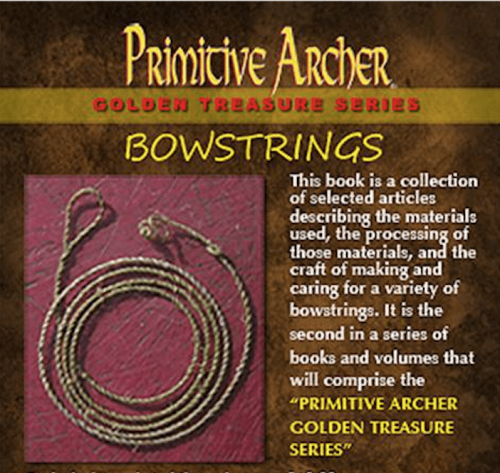 This book is a collection of selected articles describing the materials used, the processing of those materials, and the craft of making and caring for a variety of bowstrings.
This book is a collection of selected articles describing the materials used, the processing of those materials, and the craft of making and caring for a variety of bowstrings. -
Sale!
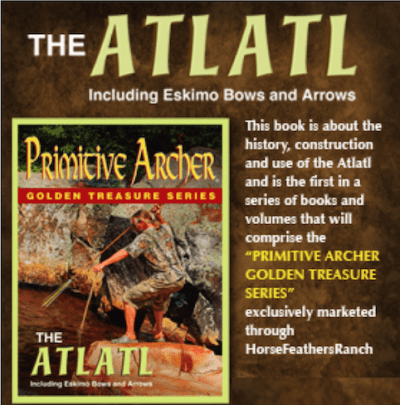 Product Description: The first of many soon to be available volumes of the Golden Treasure Series this book is comprised of 6 articles covering the Atlatl and Eskimo Bows and Arrows. This publication is an informative 54 page compilation of previously published articles from “PRIMITIVE ARCHER®” magazine. Atlatl is a word made up of two Aztec words. The first word meaning “water” and the second meaning “to throw” were combined into “atlatl”. The atlatl was believed to be used both thrust a spear into the water as a means of spearing fish. The Eskimos used atlatls to harpoon whales, seals and walruses. In North America, early man used atlatls as a means of throwing large darts into large animals such as mammoths, bison, and woolly rhinos and whatever or whoever threatened his security.” From author Lyle Doberstein. This book is about the history, construction and use of the Atlatl and is the first in a series of books and volumes that will comprise the PRIMITIVE ARCHER GOLDEN TREASURE SERIES exclusively marketed through HORSEFEATHERSRANCH and PRIMITIVE ARCHER
Product Description: The first of many soon to be available volumes of the Golden Treasure Series this book is comprised of 6 articles covering the Atlatl and Eskimo Bows and Arrows. This publication is an informative 54 page compilation of previously published articles from “PRIMITIVE ARCHER®” magazine. Atlatl is a word made up of two Aztec words. The first word meaning “water” and the second meaning “to throw” were combined into “atlatl”. The atlatl was believed to be used both thrust a spear into the water as a means of spearing fish. The Eskimos used atlatls to harpoon whales, seals and walruses. In North America, early man used atlatls as a means of throwing large darts into large animals such as mammoths, bison, and woolly rhinos and whatever or whoever threatened his security.” From author Lyle Doberstein. This book is about the history, construction and use of the Atlatl and is the first in a series of books and volumes that will comprise the PRIMITIVE ARCHER GOLDEN TREASURE SERIES exclusively marketed through HORSEFEATHERSRANCH and PRIMITIVE ARCHER -
Sale!
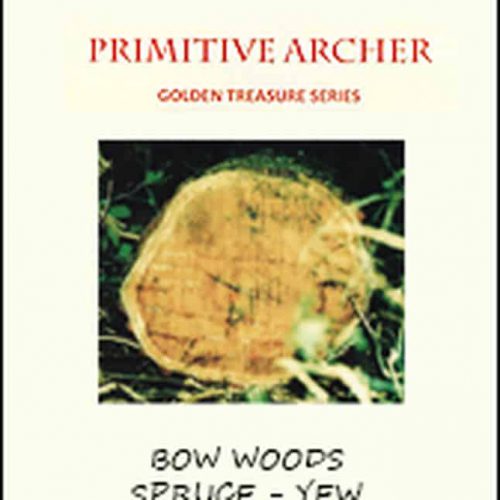
 Volumes 1-4 of Bow Woods. This includes: Vol 1 Bamboo-Elm, Vol 2 Hickory - Osage; Vol 3 Pau Amarello-Penobscot; Vol 4 Spruce -Yew Save money and buy the whole collection. These four volumes are packed with articles describing the attributes and challenges of different woods used in making self- bows as well as instructions for the collection and then preparation of those woods for processing. Many of the articles take the reader step by step all the way from collection through to the finished bow of that chosen wood. Others focus on special challenges such as “Cutting Your Own Bow Wood”, “Drying Wood” or “Follow the Grain”. buy all 4 as a set to save.
Volumes 1-4 of Bow Woods. This includes: Vol 1 Bamboo-Elm, Vol 2 Hickory - Osage; Vol 3 Pau Amarello-Penobscot; Vol 4 Spruce -Yew Save money and buy the whole collection. These four volumes are packed with articles describing the attributes and challenges of different woods used in making self- bows as well as instructions for the collection and then preparation of those woods for processing. Many of the articles take the reader step by step all the way from collection through to the finished bow of that chosen wood. Others focus on special challenges such as “Cutting Your Own Bow Wood”, “Drying Wood” or “Follow the Grain”. buy all 4 as a set to save. -
Sale!
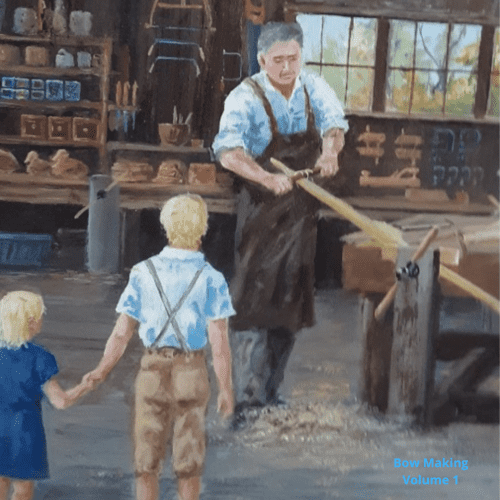
 BOW MAKING VOLUME 1 From Tree to Bow ARTICLES Osage Bow Building 101 Part 1 by Mickey Lotz Osage Bow Building 101 Part 2 by Mickey Lotz Osage Bow Building 101 Part 3 by Mickey Lotz Hickory Self Bows by Mark ”Pappy” Baggett The Pleasure of Process by John Sturtevant The Tale of Ugly Stick by Bill Marsh New Bows Stress, and Durability by Paul Comstock Short Bows No Stacking by Adam Karpowicz Making the Comanche Bow by Billy Berger 2018 Self Bow of The Year by Leon Loef 2019 Self Bow of the Year by Ryan Gauthier BOW MAKING VOLUME 2 Bow Backing ARTICLES Backing Your Bow With Buffalo Hide by Richard Longbow Snake Skin Backing by Ron Kuelsa Snake Skin Backing by Bob Uptagrafft Sinew-Backed Yellow Birch by Marc St. Louis Hickory Backing - The Available Alternative by Murray Gaskins Fish Skin Backings by Tim Ott Backing a Bow With Gar Skin by David Frana Bamboo-Backed Bow by Greg Harris Artic Cable-Backed Bows: Part 1 by A.J. Hendershott Artic Cable-Backed Bows: Part 2 by A.J. Hendershott Artic Cable-Backed Bows: Part 3 by A.J. Hendershott Backed Bow of the Month by Eddie Parker Backed Bow of the Month by Mark Baggett (Pappy) Bow Making Volume 3 Horn Bows ARTICLES Buffalo Horn Bow… by Thomas Ressler Plains Sheep Horn Bow With Bowyer Chuck Loeffler by Jay Red Hawk Shelton’s Sheep Horn Bow Build with Tom Lucas by Shelton Fitzgerald Shelton’s Sheep Horn Bow Build with Tom Lucas Part 2 by Shelton Fitzgerald Shelton’s Sheep Horn Bow Build with Tom Lucas Part 3 by Shelton Fitzgerald Shelton’s Sheep Horn Bow Build with Tom Lucas Part 4 by Shelton Fitzgerald Shelton’s Sheep Horn Bow Build with Tom Lucas Part 5 by Shelton Fitzgerald How to Construct a Turkish Horn Bow by Curtis Byrd Primitive Corner Bow Nocks by Jack Keener Backed Bow of the Month by Pat B. Self Bow of the Month by Matt Kulchak Bow Making Volume 4 Longbows and War Bows ARTICLES The Old English War Bow by Pip Bickerstaffe The Old English War Bow Part 2 by Pip Bickerstaffe The Old English War Bow Part 3 by Pip Bickerstaffe Three 18th-Century Longbows by Hugh D.H .Soar Medieval Hunting and the Longbow by Hugh D.H. Soar The Mary Rose Painting by Ed Ingold The New Mary Rose Museum by Hilary Greenland The Recreational Longbow by Hugh Soar The Recreational Longbow Bows and Arrow Boxes by Hugh Soar Bagdad Beauty by SGT Keith Gibson Bow Making Volume 5 Tools and Equipment ARTICLES Tools of the Trade by Micky Lotz Bow Building Tools Old & New by Clifford H. Rhodes Shaving Horse by Garett Beatty Barham Clamp by Gary Ashmore Making Two Tools For Assembling Bow Billets by Charles W. Palmer Treadle Shaving Horse by Neal C. Ritter Easy String Keepers and Tip Protectors by Larry Clemons A Year With Osage : Birth by Tony Kinton The Stave Warmer The Poor Man’s Stave Dryer by Ronald Prusinski All In One Tillering Board by Michael Barham Traveling Bow Bench by Bill Marsh
BOW MAKING VOLUME 1 From Tree to Bow ARTICLES Osage Bow Building 101 Part 1 by Mickey Lotz Osage Bow Building 101 Part 2 by Mickey Lotz Osage Bow Building 101 Part 3 by Mickey Lotz Hickory Self Bows by Mark ”Pappy” Baggett The Pleasure of Process by John Sturtevant The Tale of Ugly Stick by Bill Marsh New Bows Stress, and Durability by Paul Comstock Short Bows No Stacking by Adam Karpowicz Making the Comanche Bow by Billy Berger 2018 Self Bow of The Year by Leon Loef 2019 Self Bow of the Year by Ryan Gauthier BOW MAKING VOLUME 2 Bow Backing ARTICLES Backing Your Bow With Buffalo Hide by Richard Longbow Snake Skin Backing by Ron Kuelsa Snake Skin Backing by Bob Uptagrafft Sinew-Backed Yellow Birch by Marc St. Louis Hickory Backing - The Available Alternative by Murray Gaskins Fish Skin Backings by Tim Ott Backing a Bow With Gar Skin by David Frana Bamboo-Backed Bow by Greg Harris Artic Cable-Backed Bows: Part 1 by A.J. Hendershott Artic Cable-Backed Bows: Part 2 by A.J. Hendershott Artic Cable-Backed Bows: Part 3 by A.J. Hendershott Backed Bow of the Month by Eddie Parker Backed Bow of the Month by Mark Baggett (Pappy) Bow Making Volume 3 Horn Bows ARTICLES Buffalo Horn Bow… by Thomas Ressler Plains Sheep Horn Bow With Bowyer Chuck Loeffler by Jay Red Hawk Shelton’s Sheep Horn Bow Build with Tom Lucas by Shelton Fitzgerald Shelton’s Sheep Horn Bow Build with Tom Lucas Part 2 by Shelton Fitzgerald Shelton’s Sheep Horn Bow Build with Tom Lucas Part 3 by Shelton Fitzgerald Shelton’s Sheep Horn Bow Build with Tom Lucas Part 4 by Shelton Fitzgerald Shelton’s Sheep Horn Bow Build with Tom Lucas Part 5 by Shelton Fitzgerald How to Construct a Turkish Horn Bow by Curtis Byrd Primitive Corner Bow Nocks by Jack Keener Backed Bow of the Month by Pat B. Self Bow of the Month by Matt Kulchak Bow Making Volume 4 Longbows and War Bows ARTICLES The Old English War Bow by Pip Bickerstaffe The Old English War Bow Part 2 by Pip Bickerstaffe The Old English War Bow Part 3 by Pip Bickerstaffe Three 18th-Century Longbows by Hugh D.H .Soar Medieval Hunting and the Longbow by Hugh D.H. Soar The Mary Rose Painting by Ed Ingold The New Mary Rose Museum by Hilary Greenland The Recreational Longbow by Hugh Soar The Recreational Longbow Bows and Arrow Boxes by Hugh Soar Bagdad Beauty by SGT Keith Gibson Bow Making Volume 5 Tools and Equipment ARTICLES Tools of the Trade by Micky Lotz Bow Building Tools Old & New by Clifford H. Rhodes Shaving Horse by Garett Beatty Barham Clamp by Gary Ashmore Making Two Tools For Assembling Bow Billets by Charles W. Palmer Treadle Shaving Horse by Neal C. Ritter Easy String Keepers and Tip Protectors by Larry Clemons A Year With Osage : Birth by Tony Kinton The Stave Warmer The Poor Man’s Stave Dryer by Ronald Prusinski All In One Tillering Board by Michael Barham Traveling Bow Bench by Bill Marsh -
Sale!
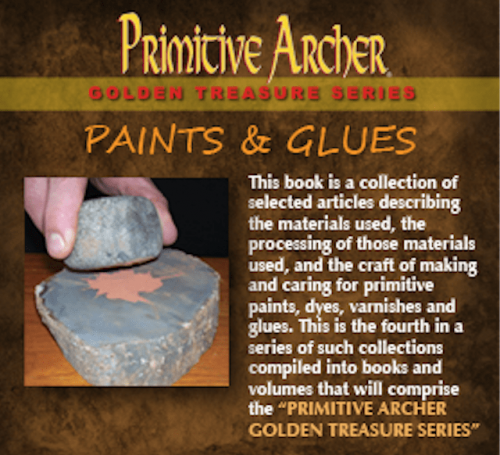 PAINTS & GLUES is packed with articles on collecting and processing earth pigments, plant and berry juices, pine pitch, sinew, rawhide and other materials used in making primitive paints, dyes, stains, varnish and glue as well as the step-by-step procedures in making each of these products. This is the fourth of a series of such collections compiled toto books and volumes that comprise the "Primitive Archer Golden Treasure Series". "Before the introduction of commercial colors, primitive cultures used natural paints and dyes that came from the earth. Those same colors are still available today and, with a little search and some work, you can find and make your own paints." Source of the quote: Author Billy Berger "In our quest to become more self-sufficient, searching out products we can make ourselves can satisfy this need. Hide glue is one of the items that can easily be made on your own ." Source of the quote: Author Mike Yancey.
PAINTS & GLUES is packed with articles on collecting and processing earth pigments, plant and berry juices, pine pitch, sinew, rawhide and other materials used in making primitive paints, dyes, stains, varnish and glue as well as the step-by-step procedures in making each of these products. This is the fourth of a series of such collections compiled toto books and volumes that comprise the "Primitive Archer Golden Treasure Series". "Before the introduction of commercial colors, primitive cultures used natural paints and dyes that came from the earth. Those same colors are still available today and, with a little search and some work, you can find and make your own paints." Source of the quote: Author Billy Berger "In our quest to become more self-sufficient, searching out products we can make ourselves can satisfy this need. Hide glue is one of the items that can easily be made on your own ." Source of the quote: Author Mike Yancey. -
Sale!
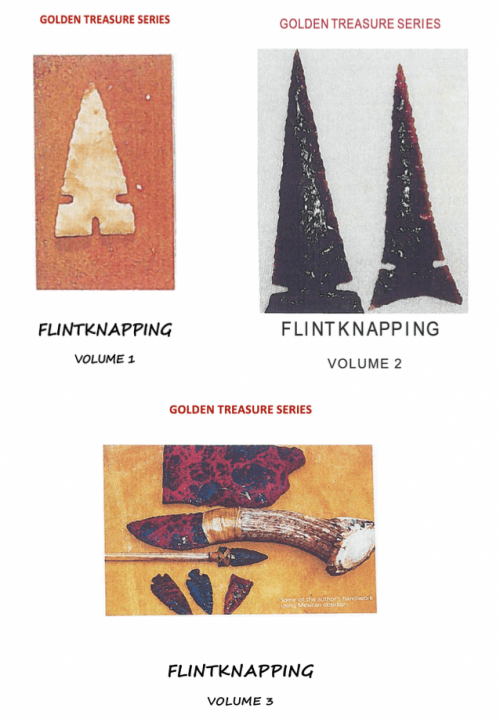
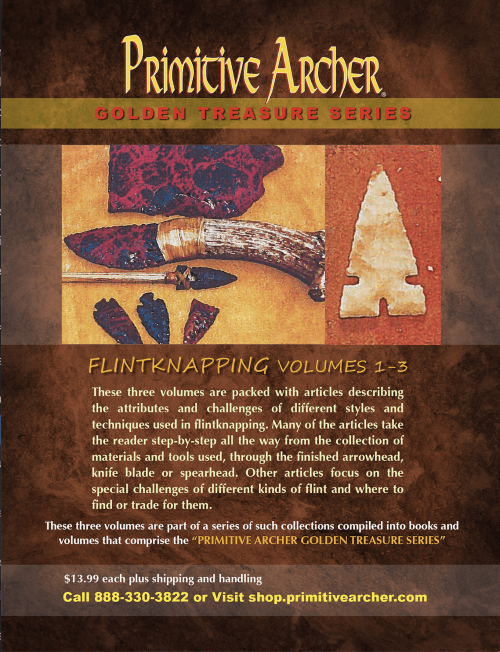 These three volumes are packed with articles describing the attributes and challenges of different styles and different techniques used in flintknapping. Many of the articles take the reader step by step all the way from the collection of materials and tools used, through the finished arrowhead, knife blade or spearhead. Other articles focus on the special challenges of different kinds of flint and where to find or trade for them. These three volumes are part of a series of such collections compiled into books and volumes that comprise the “PRIMITIVE ARCHER GOLDEN TREASURE SERIES”
These three volumes are packed with articles describing the attributes and challenges of different styles and different techniques used in flintknapping. Many of the articles take the reader step by step all the way from the collection of materials and tools used, through the finished arrowhead, knife blade or spearhead. Other articles focus on the special challenges of different kinds of flint and where to find or trade for them. These three volumes are part of a series of such collections compiled into books and volumes that comprise the “PRIMITIVE ARCHER GOLDEN TREASURE SERIES” -
Sale!
 BOW MAKING VOLUME 1 These five volumes are packed with articles describing the attributes and challenges of different styles and different techniques and equipment used in making bows. Many of the articles take the reader step by step, with numbered photos, all the way through to the finished bow. Other articles focus on special challenges such as utilizing a variety of bow backing materials, and building horn bows, longbows and war bows. These five volumes are part of a series of such collections compiled into books and volumes that comprise the “Primitive Archer Golden Treasure Series”. “Although we can never return to the days when wild Native Americans roamed free over endless prairies, we can at least touch a fragment of their lost way of life by recreating and using their weapons exactly as they did during those times.” By Billy Berger “This article covers the way I make bows. There are many bowyers, with many methods, often different than those outlined here. Books and videos are readily available, and I encourage you to get them all. The more you learn, the easier bow making becomes. By necessity I could not cover every aspect of bow making in this article- that would take a book – but hopefully I have armed you with enough knowledge that you are able to turn a piece of wood into a bow.” By Mickey Lotz “The entire issue of how wooden bows break in, and what can be done to prevent problems, is a study in how stress can affect a wooden bow. My goal here is to offer some specific examples of stress-related phenomena that others can consider as they develop or refine their own methods." By Paul Comstock
BOW MAKING VOLUME 1 These five volumes are packed with articles describing the attributes and challenges of different styles and different techniques and equipment used in making bows. Many of the articles take the reader step by step, with numbered photos, all the way through to the finished bow. Other articles focus on special challenges such as utilizing a variety of bow backing materials, and building horn bows, longbows and war bows. These five volumes are part of a series of such collections compiled into books and volumes that comprise the “Primitive Archer Golden Treasure Series”. “Although we can never return to the days when wild Native Americans roamed free over endless prairies, we can at least touch a fragment of their lost way of life by recreating and using their weapons exactly as they did during those times.” By Billy Berger “This article covers the way I make bows. There are many bowyers, with many methods, often different than those outlined here. Books and videos are readily available, and I encourage you to get them all. The more you learn, the easier bow making becomes. By necessity I could not cover every aspect of bow making in this article- that would take a book – but hopefully I have armed you with enough knowledge that you are able to turn a piece of wood into a bow.” By Mickey Lotz “The entire issue of how wooden bows break in, and what can be done to prevent problems, is a study in how stress can affect a wooden bow. My goal here is to offer some specific examples of stress-related phenomena that others can consider as they develop or refine their own methods." By Paul Comstock -
Sale!
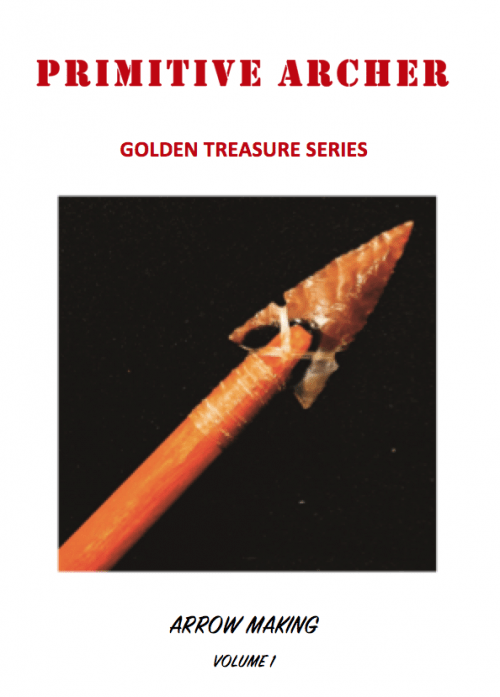 These four volumes are packed with articles describing the attributes and challenges of different styles and different techniques used in making arrows. Many of the articles take the reader step by step all the way from collection of materials to be used through to the finished arrow. Other articles focus on special challenges such as fletching, cutting nocks and spine testing arrow shafts.
These four volumes are packed with articles describing the attributes and challenges of different styles and different techniques used in making arrows. Many of the articles take the reader step by step all the way from collection of materials to be used through to the finished arrow. Other articles focus on special challenges such as fletching, cutting nocks and spine testing arrow shafts. -
Sale!

 Volumes 1-6 of Medicine Man. This includes: Vol 1 Bamboo-Elm, Vol 2 Hickory - Osage; Vol 3 Pau Amarello-Penobscot; Vol 4 Spruce -Yew Save money and buy the whole collection. These four volumes are packed with articles describing the attributes and challenges of different woods used in making self- bows as well as instructions for the collection and then preparation of those woods for processing. Many of the articles take the reader step by step all the way from collection through to the finished bow of that chosen wood. Others focus on special challenges such as “Cutting Your Own Bow Wood”, “Drying Wood” or “Follow the Grain”.
Volumes 1-6 of Medicine Man. This includes: Vol 1 Bamboo-Elm, Vol 2 Hickory - Osage; Vol 3 Pau Amarello-Penobscot; Vol 4 Spruce -Yew Save money and buy the whole collection. These four volumes are packed with articles describing the attributes and challenges of different woods used in making self- bows as well as instructions for the collection and then preparation of those woods for processing. Many of the articles take the reader step by step all the way from collection through to the finished bow of that chosen wood. Others focus on special challenges such as “Cutting Your Own Bow Wood”, “Drying Wood” or “Follow the Grain”. -
Sale!
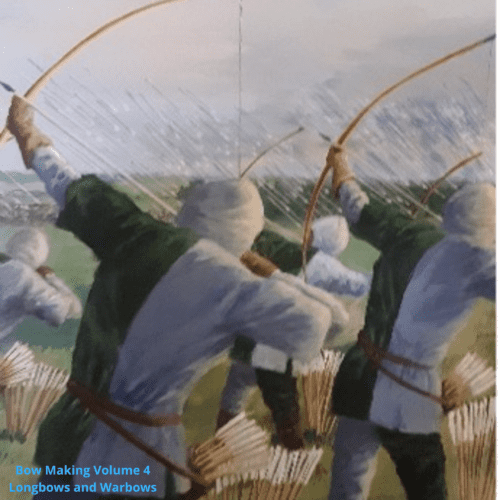 Bow Making Volume 4 Longbows and War Bows These five volumes are packed with articles describing the attributes and challenges of different styles and different techniques and equipment used in making bows. Many of the articles take the reader step by step, with numbered photos, all the way through to the finished bow. Other articles focus on special challenges such as utilizing a variety of bow backing materials, and building horn bows, longbows and war bows. These five volumes are part of a series of such collections compiled into books and volumes that comprise the “Primitive Archer Golden Treasure Series”. “Although we can never return to the days when wild Native Americans roamed free over endless prairies, we can at least touch a fragment of their lost way of life by recreating and using their weapons exactly as they did during those times.” By Billy Berger “This article covers the way I make bows. There are many bowyers, with many methods, often different than those outlined here. Books and videos are readily available, and I encourage you to get them all. The more you learn, the easier bow making becomes. By necessity I could not cover every aspect of bow making in this article- that would take a book – but hopefully I have armed you with enough knowledge that you are able to turn a piece of wood into a bow.” By Mickey Lotz “The entire issue of how wooden bows break in, and what can be done to prevent problems, is a study in how stress can affect a wooden bow. My goal here is to offer some specific examples of stress-related phenomena that others can consider as they develop or refine their own methods." By Paul Comstock
Bow Making Volume 4 Longbows and War Bows These five volumes are packed with articles describing the attributes and challenges of different styles and different techniques and equipment used in making bows. Many of the articles take the reader step by step, with numbered photos, all the way through to the finished bow. Other articles focus on special challenges such as utilizing a variety of bow backing materials, and building horn bows, longbows and war bows. These five volumes are part of a series of such collections compiled into books and volumes that comprise the “Primitive Archer Golden Treasure Series”. “Although we can never return to the days when wild Native Americans roamed free over endless prairies, we can at least touch a fragment of their lost way of life by recreating and using their weapons exactly as they did during those times.” By Billy Berger “This article covers the way I make bows. There are many bowyers, with many methods, often different than those outlined here. Books and videos are readily available, and I encourage you to get them all. The more you learn, the easier bow making becomes. By necessity I could not cover every aspect of bow making in this article- that would take a book – but hopefully I have armed you with enough knowledge that you are able to turn a piece of wood into a bow.” By Mickey Lotz “The entire issue of how wooden bows break in, and what can be done to prevent problems, is a study in how stress can affect a wooden bow. My goal here is to offer some specific examples of stress-related phenomena that others can consider as they develop or refine their own methods." By Paul Comstock -
Sale!
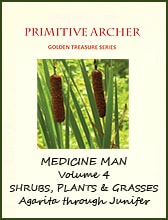 This book is the fourth Volume of 6 that are a collection of selected articles describing a variety of the materials used, as well as the processing and application of these natural materials in healing the injured and the sick. The first three volumes cover over fifty different varieties of trees. The next three volumes cover a like number of shrubs, grasses and plants. Medicine Man is the fifth title in a series of such collections. This volume covers shrubs, plants, and grasses Agarita through Juniper.
This book is the fourth Volume of 6 that are a collection of selected articles describing a variety of the materials used, as well as the processing and application of these natural materials in healing the injured and the sick. The first three volumes cover over fifty different varieties of trees. The next three volumes cover a like number of shrubs, grasses and plants. Medicine Man is the fifth title in a series of such collections. This volume covers shrubs, plants, and grasses Agarita through Juniper. -
Sale!
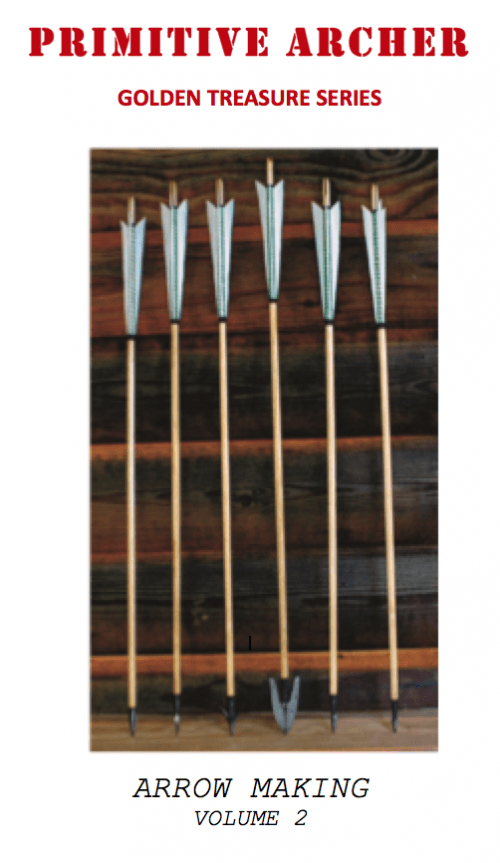 These four volumes are packed with articles describing the attributes and challenges of different styles and different techniques used in making arrows. Many of the articles take the reader step by step all the way from collection of materials to be used through to the finished arrow. Other articles focus on special challenges such as fletching, cutting nocks and spine testing arrow shafts.
These four volumes are packed with articles describing the attributes and challenges of different styles and different techniques used in making arrows. Many of the articles take the reader step by step all the way from collection of materials to be used through to the finished arrow. Other articles focus on special challenges such as fletching, cutting nocks and spine testing arrow shafts. -
Sale!
 These four volumes are packed with articles describing the attributes and challenges of different styles and different techniques used in making arrows. Many of the articles take the reader step by step all the way from collection of materials to be used through to the finished arrow. Other articles focus on special challenges such as fletching, cutting nocks and spine testing arrow shafts.
These four volumes are packed with articles describing the attributes and challenges of different styles and different techniques used in making arrows. Many of the articles take the reader step by step all the way from collection of materials to be used through to the finished arrow. Other articles focus on special challenges such as fletching, cutting nocks and spine testing arrow shafts. -
Sale!
 This book is the first Volume of 6 that are a collection of selected articles describing a variety of the materials used, as well as the processing and application of these natural materials in healing the injured and the sick. The first three volumes cover over fifty different varieties of trees. The next three volumes cover a like number of shrubs, grasses and plants. Medicine Man is the fifth title in a series of such collections. This volume covers trees Alder through Hemlock.
This book is the first Volume of 6 that are a collection of selected articles describing a variety of the materials used, as well as the processing and application of these natural materials in healing the injured and the sick. The first three volumes cover over fifty different varieties of trees. The next three volumes cover a like number of shrubs, grasses and plants. Medicine Man is the fifth title in a series of such collections. This volume covers trees Alder through Hemlock. -
Sale!
 Bow Making Volume 3 Horn Bows These five volumes are packed with articles describing the attributes and challenges of different styles and different techniques and equipment used in making bows. Many of the articles take the reader step by step, with numbered photos, all the way through to the finished bow. Other articles focus on special challenges such as utilizing a variety of bow backing materials, and building horn bows, longbows and war bows. These five volumes are part of a series of such collections compiled into books and volumes that comprise the “Primitive Archer Golden Treasure Series”. “Although we can never return to the days when wild Native Americans roamed free over endless prairies, we can at least touch a fragment of their lost way of life by recreating and using their weapons exactly as they did during those times.” By Billy Berger “This article covers the way I make bows. There are many bowyers, with many methods, often different than those outlined here. Books and videos are readily available, and I encourage you to get them all. The more you learn, the easier bow making becomes. By necessity I could not cover every aspect of bow making in this article- that would take a book – but hopefully I have armed you with enough knowledge that you are able to turn a piece of wood into a bow.” By Mickey Lotz “The entire issue of how wooden bows break in, and what can be done to prevent problems, is a study in how stress can affect a wooden bow. My goal here is to offer some specific examples of stress-related phenomena that others can consider as they develop or refine their own methods." By Paul Comstock
Bow Making Volume 3 Horn Bows These five volumes are packed with articles describing the attributes and challenges of different styles and different techniques and equipment used in making bows. Many of the articles take the reader step by step, with numbered photos, all the way through to the finished bow. Other articles focus on special challenges such as utilizing a variety of bow backing materials, and building horn bows, longbows and war bows. These five volumes are part of a series of such collections compiled into books and volumes that comprise the “Primitive Archer Golden Treasure Series”. “Although we can never return to the days when wild Native Americans roamed free over endless prairies, we can at least touch a fragment of their lost way of life by recreating and using their weapons exactly as they did during those times.” By Billy Berger “This article covers the way I make bows. There are many bowyers, with many methods, often different than those outlined here. Books and videos are readily available, and I encourage you to get them all. The more you learn, the easier bow making becomes. By necessity I could not cover every aspect of bow making in this article- that would take a book – but hopefully I have armed you with enough knowledge that you are able to turn a piece of wood into a bow.” By Mickey Lotz “The entire issue of how wooden bows break in, and what can be done to prevent problems, is a study in how stress can affect a wooden bow. My goal here is to offer some specific examples of stress-related phenomena that others can consider as they develop or refine their own methods." By Paul Comstock -
Sale!
 BOW MAKING VOLUME 2 Bow Backing These five volumes are packed with articles describing the attributes and challenges of different styles and different techniques and equipment used in making bows. Many of the articles take the reader step by step, with numbered photos, all the way through to the finished bow. Other articles focus on special challenges such as utilizing a variety of bow backing materials, and building horn bows, longbows and war bows. These five volumes are part of a series of such collections compiled into books and volumes that comprise the “Primitive Archer Golden Treasure Series”. “Although we can never return to the days when wild Native Americans roamed free over endless prairies, we can at least touch a fragment of their lost way of life by recreating and using their weapons exactly as they did during those times.” By Billy Berger “This article covers the way I make bows. There are many bowyers, with many methods, often different than those outlined here. Books and videos are readily available, and I encourage you to get them all. The more you learn, the easier bow making becomes. By necessity I could not cover every aspect of bow making in this article- that would take a book – but hopefully I have armed you with enough knowledge that you are able to turn a piece of wood into a bow.” By Mickey Lotz “The entire issue of how wooden bows break in, and what can be done to prevent problems, is a study in how stress can affect a wooden bow. My goal here is to offer some specific examples of stress-related phenomena that others can consider as they develop or refine their own methods." By Paul Comstock
BOW MAKING VOLUME 2 Bow Backing These five volumes are packed with articles describing the attributes and challenges of different styles and different techniques and equipment used in making bows. Many of the articles take the reader step by step, with numbered photos, all the way through to the finished bow. Other articles focus on special challenges such as utilizing a variety of bow backing materials, and building horn bows, longbows and war bows. These five volumes are part of a series of such collections compiled into books and volumes that comprise the “Primitive Archer Golden Treasure Series”. “Although we can never return to the days when wild Native Americans roamed free over endless prairies, we can at least touch a fragment of their lost way of life by recreating and using their weapons exactly as they did during those times.” By Billy Berger “This article covers the way I make bows. There are many bowyers, with many methods, often different than those outlined here. Books and videos are readily available, and I encourage you to get them all. The more you learn, the easier bow making becomes. By necessity I could not cover every aspect of bow making in this article- that would take a book – but hopefully I have armed you with enough knowledge that you are able to turn a piece of wood into a bow.” By Mickey Lotz “The entire issue of how wooden bows break in, and what can be done to prevent problems, is a study in how stress can affect a wooden bow. My goal here is to offer some specific examples of stress-related phenomena that others can consider as they develop or refine their own methods." By Paul Comstock -
Sale!
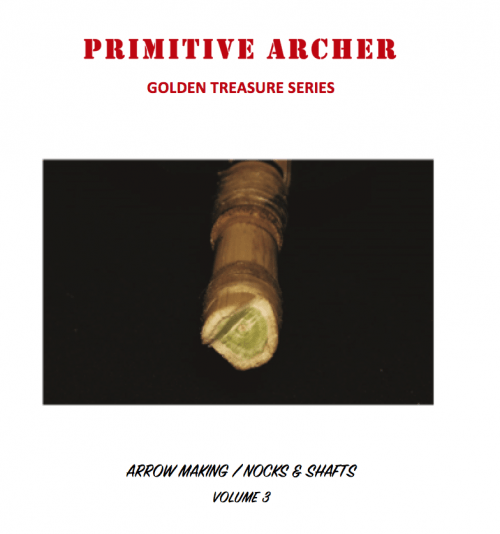 This is Volume 3 of 4 that are packed with articles describing the attributes and challenges of different styles and different techniques used in making arrows. Many of the articles take the reader step by step all the way from collection of materials to be used through to the finished arrow. Other articles focus on special challenges such as fletching, cutting nocks and spine testing arrow shafts.
This is Volume 3 of 4 that are packed with articles describing the attributes and challenges of different styles and different techniques used in making arrows. Many of the articles take the reader step by step all the way from collection of materials to be used through to the finished arrow. Other articles focus on special challenges such as fletching, cutting nocks and spine testing arrow shafts. -
Sale!
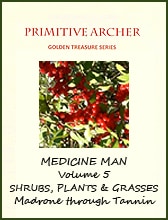 This book is the fifth Volume of 6 that are a collection of selected articles describing a variety of the materials used, as well as the processing and application of these natural materials in healing the injured and the sick. The first three volumes cover over fifty different varieties of trees. The next three volumes cover a like number of shrubs, grasses and plants. Medicine Man is the fifth title in a series of such collections. This volume covers shrubs, plants, and grasses Madrone through Tannin.
This book is the fifth Volume of 6 that are a collection of selected articles describing a variety of the materials used, as well as the processing and application of these natural materials in healing the injured and the sick. The first three volumes cover over fifty different varieties of trees. The next three volumes cover a like number of shrubs, grasses and plants. Medicine Man is the fifth title in a series of such collections. This volume covers shrubs, plants, and grasses Madrone through Tannin. -
Sale!
 These four volumes are packed with articles describing the attributes and challenges of different woods used in making self- bows as well as instructions for the collection and then preparation of those woods for processing. Many of the articles take the reader step by step all the way from collection through to the finished bow of that chosen wood. Others focus on special challenges such as “Cutting Your Own Bow Wood”, “Drying Wood” or “Follow the Grain”.
These four volumes are packed with articles describing the attributes and challenges of different woods used in making self- bows as well as instructions for the collection and then preparation of those woods for processing. Many of the articles take the reader step by step all the way from collection through to the finished bow of that chosen wood. Others focus on special challenges such as “Cutting Your Own Bow Wood”, “Drying Wood” or “Follow the Grain”. -
Sale!
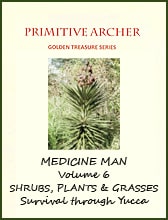 This book is the sixth Volume of 6 that are a collection of selected articles describing a variety of the materials used, as well as the processing and application of these natural materials in healing the injured and the sick. The first three volumes cover over fifty different varieties of trees. The next three volumes cover a like number of shrubs, grasses and plants. Medicine Man is the fifth title in a series of such collections. This volume covers shrubs, plants, and grasses Survival through Yucca.
This book is the sixth Volume of 6 that are a collection of selected articles describing a variety of the materials used, as well as the processing and application of these natural materials in healing the injured and the sick. The first three volumes cover over fifty different varieties of trees. The next three volumes cover a like number of shrubs, grasses and plants. Medicine Man is the fifth title in a series of such collections. This volume covers shrubs, plants, and grasses Survival through Yucca. -
Sale!
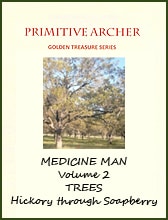 This book is the second Volume of 6 that are a collection of selected articles describing a variety of the materials used, as well as the processing and application of these natural materials in healing the injured and the sick. The first three volumes cover over fifty different varieties of trees. The next three volumes cover a like number of shrubs, grasses and plants. Medicine Man is the fifth title in a series of such collections. This volume covers trees Hickory through Soapberry.
This book is the second Volume of 6 that are a collection of selected articles describing a variety of the materials used, as well as the processing and application of these natural materials in healing the injured and the sick. The first three volumes cover over fifty different varieties of trees. The next three volumes cover a like number of shrubs, grasses and plants. Medicine Man is the fifth title in a series of such collections. This volume covers trees Hickory through Soapberry. -
Sale!
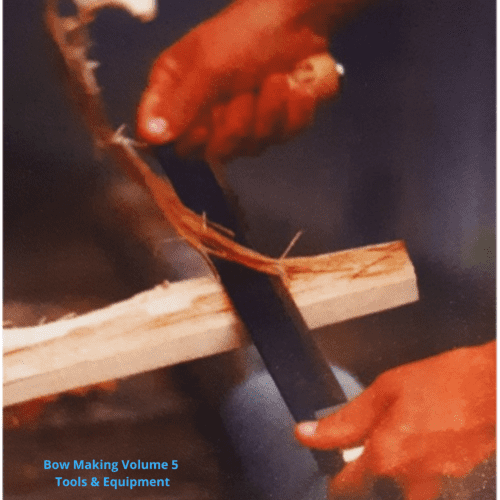 Bow Making Volume 5 Tools and Equipment These five volumes are packed with articles describing the attributes and challenges of different styles and different techniques and equipment used in making bows. Many of the articles take the reader step by step, with numbered photos, all the way through to the finished bow. Other articles focus on special challenges such as utilizing a variety of bow backing materials, and building horn bows, longbows and war bows. These five volumes are part of a series of such collections compiled into books and volumes that comprise the “Primitive Archer Golden Treasure Series”. “Although we can never return to the days when wild Native Americans roamed free over endless prairies, we can at least touch a fragment of their lost way of life by recreating and using their weapons exactly as they did during those times.” By Billy Berger “This article covers the way I make bows. There are many bowyers, with many methods, often different than those outlined here. Books and videos are readily available, and I encourage you to get them all. The more you learn, the easier bow making becomes. By necessity I could not cover every aspect of bow making in this article- that would take a book – but hopefully I have armed you with enough knowledge that you are able to turn a piece of wood into a bow.” By Mickey Lotz “The entire issue of how wooden bows break in, and what can be done to prevent problems, is a study in how stress can affect a wooden bow. My goal here is to offer some specific examples of stress-related phenomena that others can consider as they develop or refine their own methods." By Paul Comstock
Bow Making Volume 5 Tools and Equipment These five volumes are packed with articles describing the attributes and challenges of different styles and different techniques and equipment used in making bows. Many of the articles take the reader step by step, with numbered photos, all the way through to the finished bow. Other articles focus on special challenges such as utilizing a variety of bow backing materials, and building horn bows, longbows and war bows. These five volumes are part of a series of such collections compiled into books and volumes that comprise the “Primitive Archer Golden Treasure Series”. “Although we can never return to the days when wild Native Americans roamed free over endless prairies, we can at least touch a fragment of their lost way of life by recreating and using their weapons exactly as they did during those times.” By Billy Berger “This article covers the way I make bows. There are many bowyers, with many methods, often different than those outlined here. Books and videos are readily available, and I encourage you to get them all. The more you learn, the easier bow making becomes. By necessity I could not cover every aspect of bow making in this article- that would take a book – but hopefully I have armed you with enough knowledge that you are able to turn a piece of wood into a bow.” By Mickey Lotz “The entire issue of how wooden bows break in, and what can be done to prevent problems, is a study in how stress can affect a wooden bow. My goal here is to offer some specific examples of stress-related phenomena that others can consider as they develop or refine their own methods." By Paul Comstock -
Sale!
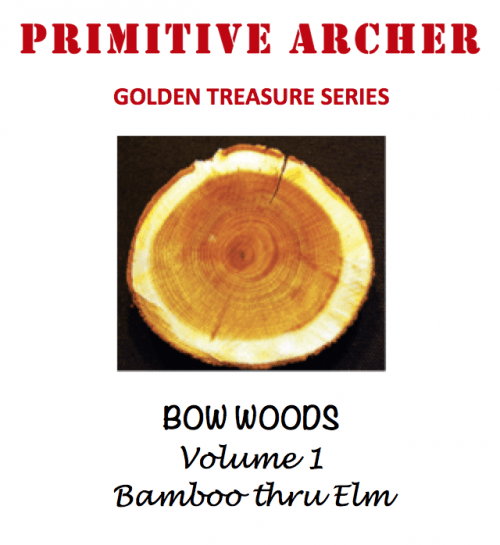 These four volumes are packed with articles describing the attributes and challenges of different woods used in making self- bows as well as instructions for the collection and then preparation of those woods for processing. Many of the articles take the reader step by step all the way from collection through to the finished bow of that chosen wood. Others focus on special challenges such as “Cutting Your Own Bow Wood”, “Drying Wood” or “Follow the Grain”.
These four volumes are packed with articles describing the attributes and challenges of different woods used in making self- bows as well as instructions for the collection and then preparation of those woods for processing. Many of the articles take the reader step by step all the way from collection through to the finished bow of that chosen wood. Others focus on special challenges such as “Cutting Your Own Bow Wood”, “Drying Wood” or “Follow the Grain”. -
Sale!
 This book is a collection of selected articles describing the attributes and challenges of different styles and different techniques used in flintknapping. This is the 19th of a series of such collections compiled into books and volumes that comprise the “Primitive Archer Golden Treasure Series” Articles Include: Flintknapping Today’s Ancient Craft by John Whittaker Making That Flint Arrowhead by Roger Warmuskerken Through A Beginner’s Eyes by Steven Saffold So, Let’s Make An Arrowhead by John McPherson For The Love of Stone by Billy Berger Stone Impact Fractures by Ben Gillespie Small Town Knapper by Nikki Wetzel Solving The Primitive Arrow Weight Consistency Issues by Randall Ivie Making The Calapooya Arrow Point by Billy Berger Primitive Archery’s Lessons On Stone Tool Use...by Billy Berger Tequila – My Obsidian Obsession by Rollie Johnson From The Pit – Flintknapping FAQ by Patrick Blank From The Pit – FlinkKnapping FAQ by Patrick Blank
This book is a collection of selected articles describing the attributes and challenges of different styles and different techniques used in flintknapping. This is the 19th of a series of such collections compiled into books and volumes that comprise the “Primitive Archer Golden Treasure Series” Articles Include: Flintknapping Today’s Ancient Craft by John Whittaker Making That Flint Arrowhead by Roger Warmuskerken Through A Beginner’s Eyes by Steven Saffold So, Let’s Make An Arrowhead by John McPherson For The Love of Stone by Billy Berger Stone Impact Fractures by Ben Gillespie Small Town Knapper by Nikki Wetzel Solving The Primitive Arrow Weight Consistency Issues by Randall Ivie Making The Calapooya Arrow Point by Billy Berger Primitive Archery’s Lessons On Stone Tool Use...by Billy Berger Tequila – My Obsidian Obsession by Rollie Johnson From The Pit – Flintknapping FAQ by Patrick Blank From The Pit – FlinkKnapping FAQ by Patrick Blank -
Sale!
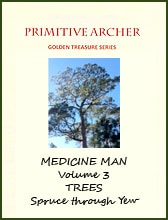 This book is the third Volume of 6 that are a collection of selected articles describing a variety of the materials used, as well as the processing and application of these natural materials in healing the injured and the sick. The first three volumes cover over fifty different varieties of trees. The next three volumes cover a like number of shrubs, grasses and plants. Medicine Man is the fifth title in a series of such collections. This volume covers trees Spruce through Yew.
This book is the third Volume of 6 that are a collection of selected articles describing a variety of the materials used, as well as the processing and application of these natural materials in healing the injured and the sick. The first three volumes cover over fifty different varieties of trees. The next three volumes cover a like number of shrubs, grasses and plants. Medicine Man is the fifth title in a series of such collections. This volume covers trees Spruce through Yew. -
Sale!

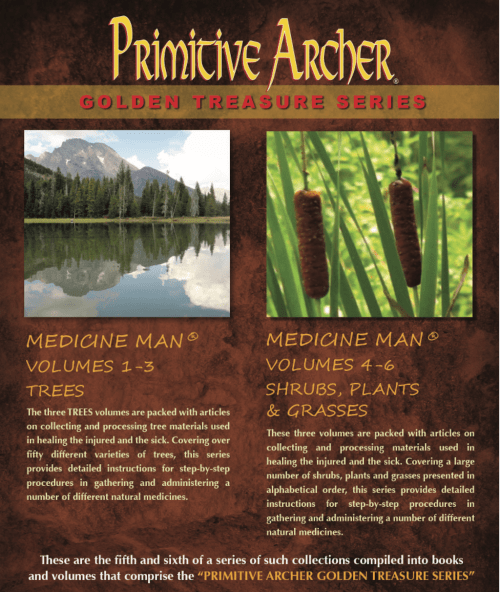 This set includes ALL 26 Golden Treasure Series books- including, All 5 Bow Making Collection; All 4 Bow Woods Volumes, All 6 Medicine Man Volumes, All 4 Arrows Volumes, All 3 Flintkapping Volumes, Quivers, Atlatls, Paints and Glues, and Bowstrings. Ships in several boxes. Ships in several boxes. You will have information on all the different types of wood used to make bows, information on plants, shrubs and trees with the Medicine Man series, and everything you would want to know about quivers, bowstrings, paints and glue, and the atlatl in your complete set of the Golden Treasure Series.
This set includes ALL 26 Golden Treasure Series books- including, All 5 Bow Making Collection; All 4 Bow Woods Volumes, All 6 Medicine Man Volumes, All 4 Arrows Volumes, All 3 Flintkapping Volumes, Quivers, Atlatls, Paints and Glues, and Bowstrings. Ships in several boxes. Ships in several boxes. You will have information on all the different types of wood used to make bows, information on plants, shrubs and trees with the Medicine Man series, and everything you would want to know about quivers, bowstrings, paints and glue, and the atlatl in your complete set of the Golden Treasure Series. -
Sale!
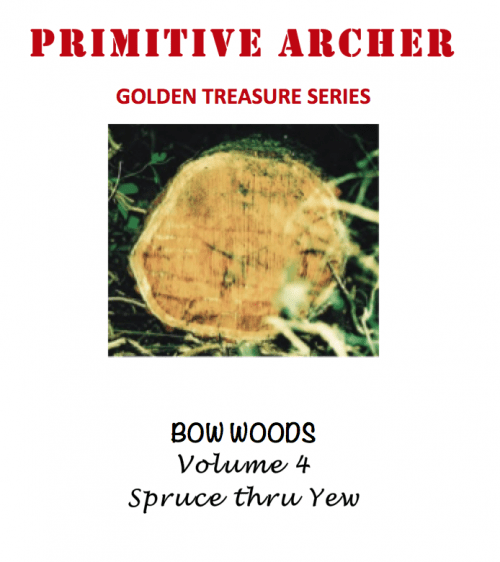 These four volumes are packed with articles describing the attributes and challenges of different woods used in making self- bows as well as instructions for the collection and then preparation of those woods for processing. Many of the articles take the reader step by step all the way from collection through to the finished bow of that chosen wood. Others focus on special challenges such as “Cutting Your Own Bow Wood”, “Drying Wood” or “Follow the Grain”.
These four volumes are packed with articles describing the attributes and challenges of different woods used in making self- bows as well as instructions for the collection and then preparation of those woods for processing. Many of the articles take the reader step by step all the way from collection through to the finished bow of that chosen wood. Others focus on special challenges such as “Cutting Your Own Bow Wood”, “Drying Wood” or “Follow the Grain”. -
Sale!
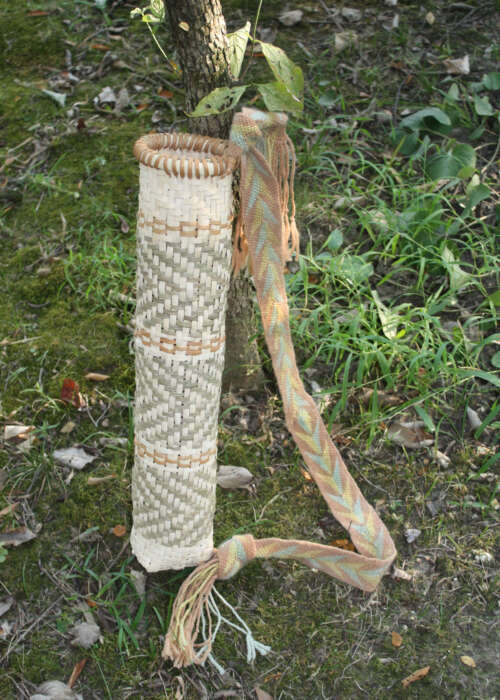
WILDERNESS CRAFTS
Volume 1
Implements & Gear
This book is a collection of selected articles describing the attributes and challenges of different wilderness crafts and skills used in creating personal implements and gear as well as the collecting and processing of the materials used in those crafts. This is the twenty-seventh of a series of such collections compiled into books and volumes that comprise the “Primitive Archer Golden Treasure Series”
ORDER OF ARTICLES
Pottery: Another Ancient Art by Andrew Heiny .Volume 28, Issue 6
Pottery: Another Ancient Art Part II by Andrew Heiny..…Volume 28, Issue 6
Coal Burning: Creating Wooden Containers by Jean and Josh Mckinley…Volume 25, Issue
A Modern Split Cane Quiver by A.J. Hendershott…Volume 28 Issue 4
Dyeing to Make A Quiver Strap by A.J. Hendershott…Volume 28, Issue 3
West Virginia Black Ash Baskets by Jim Eaves…Volume 14, Issue 3
Eye Candy Cane by Tim Ott…Volume 27, Issue 5
Making An Archer’s Thumb Ring by Robert E. Dohrenwend…Volume 8, Issue 3
Milkweed Cordage by Rollie Johnson…Volume 16, Issue 3
-
Sale!
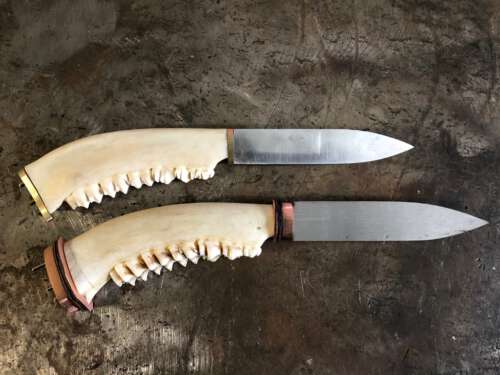
WILDERNESS CRAFTS
Volume 2
Implements & Gear
This book is a collection of selected articles describing the attributes and challenges of different wilderness crafts and skills used in creating personal implements and gear as well as the collecting and processing of the materials used in those crafts. This is the twenty-seventh of a series of such collections compiled into books and volumes that comprise the
“Primitive Archer Golden Treasure Series”
ORDER OF ARTICLES
Knife Making: For Richer or Poorer by Bill Priest-Volume 28, Issue 3
An Ax For Making Stick Bows by Stim Wilcox and Larry Balchen-Volume 28, Issue 5
Applying a Cane Grip by Jonathan Hall-Volume 16, Issue 5
The Use of Flax Twine in Bowmaking by Bartlomiej Grygiel-Volume 30, Issue 1
Birch Bark Canoe by John Lindman-Volume 12, Issue 1
Part II: Assembling The Birch Bark Canoe-by John Lindman-Volume 12, Issue 2
Birch Bark Quiver by Mark St. Louis-Volume 15, Issue 4
Pleasure of The Process by John Sturtevant-Volume 9, Issue 2
“Many of us with an interest in what has been called “primitive” or “natural” archery are attracted to simple things- things that aren’t superficial and don’t have a lot of “bells and whistles.” We enjoy these things instead of buying them. Many of us enjoy making everything we use as we pursue our interests, be they for hunting or targets. This doesn’t mean we won’t use or appreciate items made by others, but sometimes they don’t hold the same meaning as things we’ve crafted ourselves. I think many times some of us enjoy the process of making all these wonderful things as much or more than actually having them or using them.” By John Sturtevant “I was first drawn to cane as a bow grip because I was searching for a grip that was sweat proof, waterproof, low maintenance, and would provide a firm gripping surface. Rubber sleves were out because the aesthetics of them were not appealing. I first saw rattan used as a grip on the cover of The Traditional Bowyer’s Bible, Vol. 3, and I first used rattan, or cane, as a grip on my lemonwood composite bow (Primitive Archer Magazine, Feb/Mar 2007). I thought I would write some detailed instructions on how to apply a cane grip to a bow.” By Jonathan Hall “So, get ready and we’ll build a knife or two that will razzle dazzle all your friends, regardless of your skill set, or what your current economic situation may be. You can add your own twist as imagination allows. Here’s how.” By Bill Priest -
Sale!
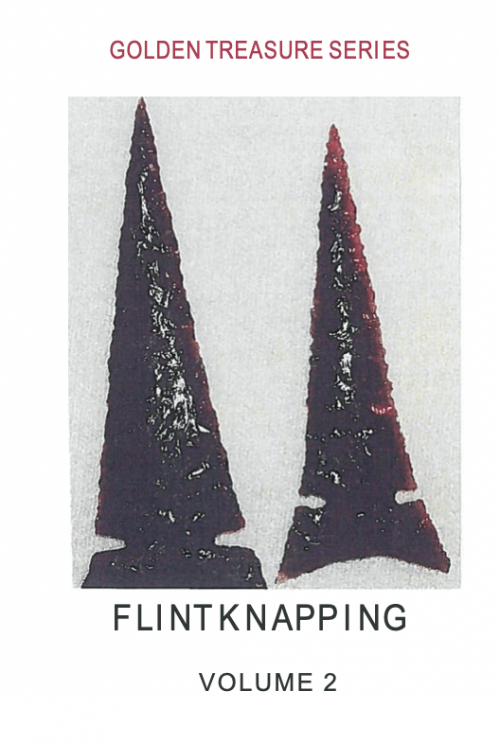 This book is a collection of selected articles describing the attributes and challenges of different styles and different techniques used in flintknapping. This is the 20th of a series of such collections compiled into books and volumes that comprise the “Primitive Archer Golden Treasure Series” Articles Include: Scary Sharp Serrations by Ryan Gill Let’s Make An Arrowhead – Part 2 by John McPherson Making The Cahokia Point by Billy Berger Rocks to Heart Shots by Ryan Gill Promoting Penetration With a Smooth Transition by Ryan Gill Making The Eastgate Arrow Point by Billy Berger Throwin’ Rocks At ‘Em by Mickey Lotz Building Self Bows and Flintknapping- Tennessee Classic by Stim Wilcox The Obsidian of Annadel and Napa Valley by Sterling Sam From The Pit – Flintknapping FAQ by Patrick Blank
This book is a collection of selected articles describing the attributes and challenges of different styles and different techniques used in flintknapping. This is the 20th of a series of such collections compiled into books and volumes that comprise the “Primitive Archer Golden Treasure Series” Articles Include: Scary Sharp Serrations by Ryan Gill Let’s Make An Arrowhead – Part 2 by John McPherson Making The Cahokia Point by Billy Berger Rocks to Heart Shots by Ryan Gill Promoting Penetration With a Smooth Transition by Ryan Gill Making The Eastgate Arrow Point by Billy Berger Throwin’ Rocks At ‘Em by Mickey Lotz Building Self Bows and Flintknapping- Tennessee Classic by Stim Wilcox The Obsidian of Annadel and Napa Valley by Sterling Sam From The Pit – Flintknapping FAQ by Patrick Blank -
Sale!
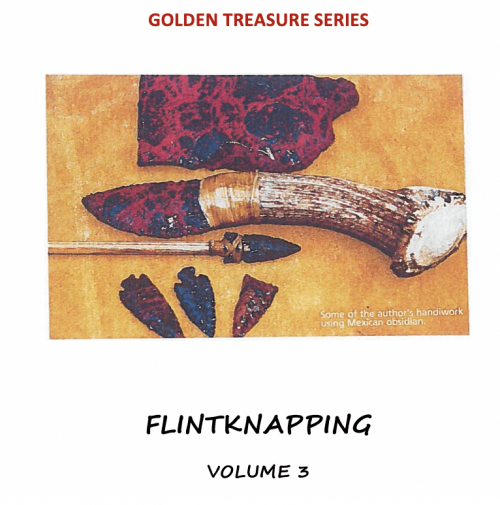 This book is a collection of selected articles describing the attributes and challenges of different styles and different techniques used in flintknapping. This is the 21st of a series of such collections compiled into books and volumes that comprise the “Primitive Archer Golden Treasure Series” Articles Include: Making The Desert Side-Notch Point by Billy Berger Glass Buttes Knap-In by Dave Cheney Let’s Make An Arrowhead – Part 3 by John McPherson Back Yard Knap-Ins by Billy Berger Replicating a Selknam Glass Arrow Point and Arrow by John Borgeson Making The Citrus Side Notched Point by Billy Berger Knapadonia by Duane Spangler From The Pit – Flintknapping FAQ by Patrick Blank From The Pit – Flintknapping FAQ by Patrick Blank Iowa Indian Artifact Show by Billy Berger From The Pit – Flintknapping FAQ by Patrick Blank
This book is a collection of selected articles describing the attributes and challenges of different styles and different techniques used in flintknapping. This is the 21st of a series of such collections compiled into books and volumes that comprise the “Primitive Archer Golden Treasure Series” Articles Include: Making The Desert Side-Notch Point by Billy Berger Glass Buttes Knap-In by Dave Cheney Let’s Make An Arrowhead – Part 3 by John McPherson Back Yard Knap-Ins by Billy Berger Replicating a Selknam Glass Arrow Point and Arrow by John Borgeson Making The Citrus Side Notched Point by Billy Berger Knapadonia by Duane Spangler From The Pit – Flintknapping FAQ by Patrick Blank From The Pit – Flintknapping FAQ by Patrick Blank Iowa Indian Artifact Show by Billy Berger From The Pit – Flintknapping FAQ by Patrick Blank -
Sale!
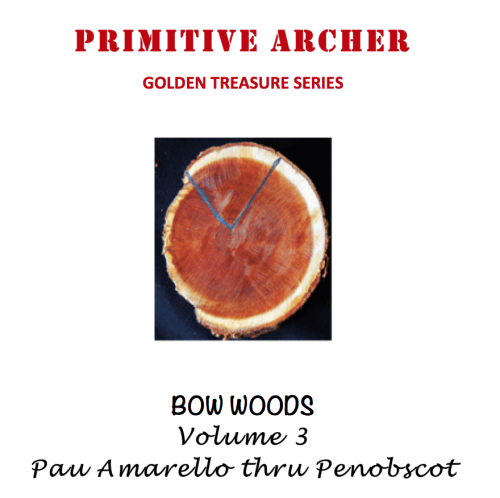 These four volumes are packed with articles describing the attributes and challenges of different woods used in making self- bows as well as instructions for the collection and then preparation of those woods for processing. Many of the articles take the reader step by step all the way from collection through to the finished bow of that chosen wood. Others focus on special challenges such as “Cutting Your Own Bow Wood”, “Drying Wood” or “Follow the Grain”.
These four volumes are packed with articles describing the attributes and challenges of different woods used in making self- bows as well as instructions for the collection and then preparation of those woods for processing. Many of the articles take the reader step by step all the way from collection through to the finished bow of that chosen wood. Others focus on special challenges such as “Cutting Your Own Bow Wood”, “Drying Wood” or “Follow the Grain”. -
Sale!

 These books are a collection of selected articles describing the attributes and challenges of different wilderness crafts and skills used in creating personal implements and gear as well as the collecting and processing of the materials used in those crafts. This is the twenty-seventh of a series of such collections compiled into books and volumes that comprise the “Primitive Archer Golden Treasure Series” This collection includes the follwing: Implements and Gear - 2 Volumes Paints and Glues - 1 Volume
These books are a collection of selected articles describing the attributes and challenges of different wilderness crafts and skills used in creating personal implements and gear as well as the collecting and processing of the materials used in those crafts. This is the twenty-seventh of a series of such collections compiled into books and volumes that comprise the “Primitive Archer Golden Treasure Series” This collection includes the follwing: Implements and Gear - 2 Volumes Paints and Glues - 1 Volume -
Sale!

 The Atlatl- This book is comprised of 6 articles covering the Atlatl and Eskimo Bows and Arrows. Bow Strings- This book is a collection of selected articles describing the materials used, the processing of those materials, and the craft of making and caring for a variety of bowstrings Quivers- This book is a collection of selected articles describing the materials used, the processing of those materials, and the craft of making and caring for a variety of quivers.Paints and Glues - PAINTS & GLUES is packed with articles on collecting and processing earth pigments, plant and berry juices, pine pitch, sinew, rawhide and other materials used in making primitive paints, dyes, stains, varnish and glue as well as the step-by-step procedures in making each of these products. Wilderness Crafts Volume 1 & 2- These books are a collection of selected articles describing the attributes and challenges of different wilderness crafts and skills used in creating personal implements and gear as well as the collecting and processing of the materials used in those crafts.
The Atlatl- This book is comprised of 6 articles covering the Atlatl and Eskimo Bows and Arrows. Bow Strings- This book is a collection of selected articles describing the materials used, the processing of those materials, and the craft of making and caring for a variety of bowstrings Quivers- This book is a collection of selected articles describing the materials used, the processing of those materials, and the craft of making and caring for a variety of quivers.Paints and Glues - PAINTS & GLUES is packed with articles on collecting and processing earth pigments, plant and berry juices, pine pitch, sinew, rawhide and other materials used in making primitive paints, dyes, stains, varnish and glue as well as the step-by-step procedures in making each of these products. Wilderness Crafts Volume 1 & 2- These books are a collection of selected articles describing the attributes and challenges of different wilderness crafts and skills used in creating personal implements and gear as well as the collecting and processing of the materials used in those crafts.
